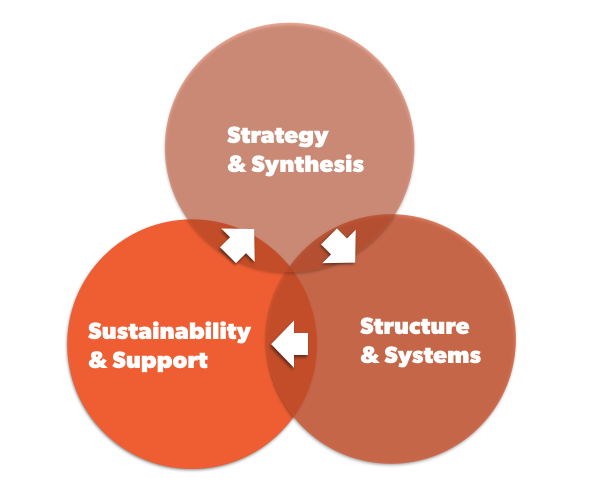
3 Pillars of a Successful Higher Education Content Strategy
Creating a sustainable content strategy framework doesn't have to be an impossible quest. Here we break down three critical pillars to help you establish a higher ed content strategy that works for your college or university.
This post was updated on February 16, 2021
When I talk to higher ed marketing communications professionals about how to create a content strategy, it sometimes seems like we’re talking about Excalibur — some exalted, unattainable relic that, if retrieved, could at last bring peace to the kingdom.
Developing and implementing a higher ed content strategy can feel overwhelming to many for a wide range of reasons, be they related to budget, time, staffing, executive buy-in, campus politics, or a perceived lack of knowledge.
“Where do I start?” I’ve heard people ask more than once.
When you’re mired in the day-to-day firefighting, the idea of pausing long enough to reflect and recalibrate seems like an impossible luxury.
As with most times when something feels overwhelming, it’s best to start by breaking it down.
What is Content Strategy?
First, let's define what we mean by content strategy. Content strategy is the plan and process you establish to support your communications goals, ensuring that the content you create is appropriate, current, accurate, sustainable, and effective.
I’ve found Kristina Halvorson’s concept of the content strategy quad super helpful in framing content strategy into more manageable components. But higher ed, with its hectic pace and highly political context, merits a slightly different approach.
A Content Strategy Approach Uniquely Designed for Higher Education
What I’ve attempted to do is create a companion to the quad viewed through a higher ed lens, taking into account both the need to solidly ground your effort in a clear purpose and to ensure its ongoing sustainability through support and measurement.
I break content strategy down into three core pillars — a triad, if you will. This framework can scale up or down, whether you’re talking about a social media campaign or a complete website overhaul.

-
Strategy & Synthesis: Clarify your communications intent and take holistic stock of your present state
-
Structure & Systems: What do the mechanisms that propel your communications forward look like, taking into consideration people, process, and technology?
-
Sustainability & Support: Define a realistic governance approach. Bonus: What you glean through this effort can help iterate your strategy and give context to your synthesis
1. Strategy & Synthesis
Give Your Higher Education Content Strategy a Purpose
Yes, it sounds a little silly that the first pillar of content strategy is strategy, but hear me out.
Strategy, in this case, just means having a purpose. Being intentional in pursuit of that purpose will take you a long way toward a successful content strategy, because you will have given your actions direction.
To create a strategy, you’ll need to define these three core elements:
-
Goals: What are we hoping to achieve? To which institutional objectives or priorities will these efforts align? What will success look like?
-
Audience: To whom are we primarily communicating, and why? Are there secondary or tertiary audiences to consider?
-
Message: What do you want to communicate? What do you want people to understand? And what information are people seeking from you?
These are core elements of strategy and putting in the effort to define them is important. If necessary, workshops with key stakeholders can help you gain consensus and clarity around these elements in a less formal, more collaborative setting.
To make sure your strategy is thorough and comprehensive, you’ll need to collect some information and do some analysis.
-
A content inventory and content audit will help you understand what content you have and how well it is working (or not working) for you, yielding valuable insight into your content gaps, needs, and opportunities.
-
User research will provide a deeper understanding of your audience, further sharpening the focus of your content strategy.
-
Stakeholder interviews will give you broader institutional perspective.
With everyone feeling heard and bought into the outcomes of those discussions, you then have a solid foundation for thinking about the best communications approach? What types of content will best serve your purpose? What stories could you tell? What mediums and formats make the most sense?
Next, with these building blocks in hand and a vision in mind, how should you proceed?
2. Structure & Systems
Bringing Content St
With the foundation of your content strategy laid down, now it’s time to start building out the structures and systems to ensure that you can execute on the strategy.
For years we thought of web content on a page-by-page level. The page was the defining structure of the content. Content today is more complex, playing out as more of a system — the content audit is a fundamental component in assessing the current state of that system.
When we say "system, " that means more than just a content management system — it means how we organize and connect pieces of information, how we establish reasonable boundaries within which our content can flourish, how we achieve consistency and best practice through adherence to defined standards, and how we manage publishing and content development across multiple (maybe two, maybe ten, maybe a hundred) authors.
Here are some of the specific considerations that fall under this umbrella:
-
Presentation & Organization: How should our content be presented and connected? What is the appropriate content hierarchy? How can taxonomy help organize content and drive dynamic publishing?
-
Publishing: What is our publishing process? What roles are involved? Are there gaps or inefficiencies in the workflow?
-
Content Planning: How will content be planned, created, and managed? Who will do this work?
-
Dynamic Content: In digital publishing, we have powerful opportunities to reuse content and leverage rich data sources to fill certain informational needs. What is our approach for dynamic publishing? How will we get the most work out of the content available to us?
-
Technology: What requirements should a potential content management system or other publishing platform meet in order to fulfill our communication needs?
-
Ownership: How is content ownership determined, and what responsibilities does ownership entail? How are editorial decisions made?
-
Standards: Do we have defined editorial guidelines and standards for content publishing, including style, branding, diversity, and accessibility?
In short, it goes far beyond pages — thinking about structure means thinking about people and process, as well. It’s all about connectivity and how we leverage it.
3. Sustainability & Support
Ensuring Content Strategy Success
Herein lies the crux of a successful content strategy — do your solutions reflect your reality? Can you meet the expectations of your strategy and structure with the time and resources available to you? Have you set yourself up for success, or struggle?
As you conceive and implement a content strategy, it is sort of like recruiting friends to help you carry a heavy sofa down the street. Did you recruit enough friends? Are they strong enough? Do they all know which direction to go? Is the distance reasonable? Did you bring water for them? Is there enough incentive for them to help you in the first place? Are you carrying your fair share while expecting them to carry theirs?
In your cases, that might mean asking: do you have the staff to get the work done? Do they have the dedicated time and the required skill sets? Is there sufficient budget for freelancers or other services?
Higher Ed Content Strategy Is a Partnership
Remember, an effective content strategy is essentially a partnership, where everyone is working with the same goals in mind. Digital governance is how you define the nature of that partnership, outlining the appropriate model for ownership, accountability, and support.
That means addressing the following questions:
-
Are roles and responsibilities clearly outlined and communicated?
-
Are training and documentation clear and accessible?
-
Are the appropriate guidelines and templates in place to take the guesswork out of the equation and consistently align people to purpose and process?
-
Is a measurement strategy in place to gauge content effectiveness and inform future content planning?
-
Is there ongoing content quality assurance?
-
Is there a clearly defined and sustainable workflow for managing day-to-day content tasks and triaging incoming requests or feedback?
-
How are you structured to communicate with the people involved in executing the content strategy, and vice versa? And are their opportunities for peer support and communication?
Providing sufficient support is critical to your success. And the less centralized your governance model, the more you need to ensure your partners in content strategy are able to hold up their end of the sofa, so to speak.
The Only Content Strategy Approach for Higher Education?
The truth is that there is no single authoritative approach for how to get content strategy work done at your institution. Content strategy in higher education rarely happens in wide, comprehensive sweeps — rather, it begins with small wins and data-driven conversations. By considering these three pillars at various inflection points of your communications effort, you arm yourself to make smarter decisions and yield more successful outcomes.
Thinking about Excalibur brings to mind one of my favorite movies as a kid, The Sword in the Stone. In the end, scrawny and scrabbly Arthur realized that he possessed the strength to draw the sword from the stone all along. We all have the strength to do something, to make progress — we just need to step up and try.
Getting Started
As you begin to apply this approach at your institution, here are some additional resources to help you get underway.
-
Learn more about content strategy — Thinking more broadly, we’ve compiled a detailed overview of the practice, its typical characteristics and activities, requirements for success, and even recommended books and podcasts.
-
Get a content strategy template — the three pillars reflected in this post are reinforced through this handy five-phase content strategy implementation process. We’ve got a downloadable template and a step-by-step approach to structure your effort.
-
Dive into your content inventory and content audit — The bedrock of a good content strategy is a solid assessment of what content you have and what it needs in order to succeed. That’s where the content inventory and content audit come in. Check out our helpful guides and learn not just how to setup an inventory or an audit, but the value you can glean from these activities.
-
Plan for web governance — Your content strategy can only succeed if you hold yourself accountable to it. This often entails a substantive change in perspective and process around how your website is managed. Here, we break down the positive outcomes of web governance and what it requires for success.
-
Content development – when you're ready to start writing, be sure to check out our recommendations for managing a content development for a website redesign.
Need more guidance? I created a five-day email course that can help walk you through the development of your content strategy.
Key Content Opportunities
As you begin to think more intently about the content that best serves your goals, we’ve got some helpful resources on the following topics that, in our experiences, tend to be major areas of opportunity for a higher ed content strategy:
This post was originally published in 2018.